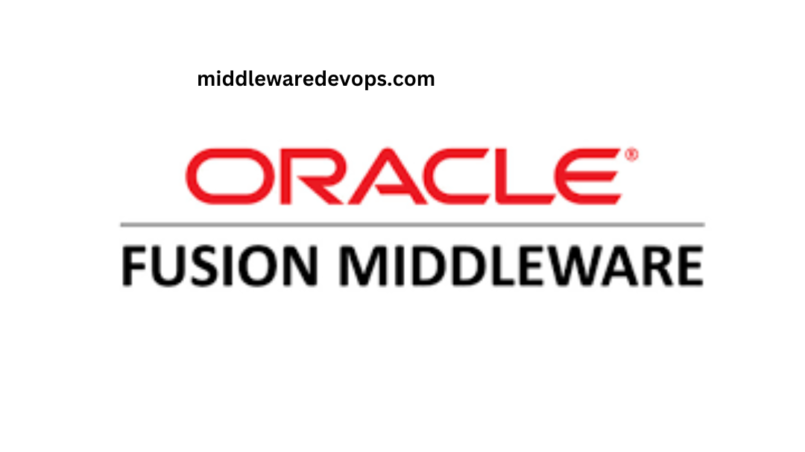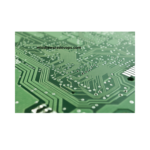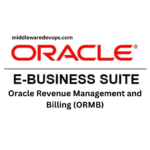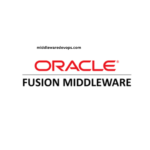Overview:
In this Blog, we will learn about the Oracle Fusion Middleware Stack. We will go through the features and components of Fusion Middleware in detail. Lets start with the fundamental definition:
Oracle Fusion Middleware is a comprehensive suite of middleware software products that enables enterprises to build, deploy, and manage complex applications and services in a flexible and scalable manner. It offers a wide range of services, including application development, business intelligence, integration, content management, identity management, and more. In this article, we will discuss the features, components, and benefits of Oracle Fusion Middleware.
Overview of Oracle Fusion Middleware:
Oracle Fusion Middleware is a middleware platform that provides a set of modular, pre-integrated software components and tools for developing, deploying, and managing applications. It provides a unified platform that enables enterprises to integrate and manage their business processes, information, and applications across the enterprise. It offers a comprehensive set of services that can be used by developers, administrators, and business users to design, build, and deploy applications.
Features of Oracle Fusion Middleware:
- Service-oriented Architecture (SOA): Oracle Fusion Middleware provides a SOA architecture that enables enterprises to build and deploy composite applications. SOA enables the creation of modular and reusable services that can be easily integrated with other applications.
- Integration: Oracle Fusion Middleware provides a range of integration services, including enterprise service bus (ESB), business process management (BPM), and data integration. These services enable enterprises to integrate their applications, data, and business processes across the enterprise.
- Business Intelligence (BI): Oracle Fusion Middleware provides a range of BI services, including reporting, dashboards, data mining, and analytics. These services enable enterprises to gain insights into their data and make informed business decisions.
- Content Management: Oracle Fusion Middleware provides a content management service that enables enterprises to manage their digital assets, documents, and web content.
- Identity Management: Oracle Fusion Middleware provides a comprehensive identity management service that enables enterprises to manage user identities, roles, and access to resources.
- Application Development: Oracle Fusion Middleware provides a set of tools and services for developing, testing, and deploying applications. These tools include Oracle JDeveloper, Oracle Application Development Framework (ADF), and Oracle WebLogic Server.
Components of Oracle Fusion Middleware:
- Oracle WebLogic Server: It is a scalable, enterprise-ready Java EE application server that provides a reliable platform for developing and deploying large-scale distributed applications. It supports various deployment models, including on-premises, cloud, and hybrid deployments. It also includes features such as clustering, load balancing, and high availability.
- Oracle SOA Suite: It is a comprehensive, standards-based software suite that enables the creation, deployment, and management of service-oriented architecture (SOA) applications. It includes features such as business process management (BPM), service bus, adapters, and B2B integration. It provides a unified platform for designing, deploying, and managing SOA applications.
- Oracle Business Intelligence Suite: It is a complete suite of business intelligence tools that enables users to access, analyze, and share data from a wide range of sources. It includes features such as reporting, analysis, dashboards, scorecards, and data integration. It provides a unified platform for creating and delivering business intelligence solutions.
- Oracle Identity and Access Management: It is a comprehensive suite of identity management products that enables organizations to manage user identities, access, and entitlements across enterprise applications and services. It includes features such as single sign-on, identity federation, access management, and user provisioning. It provides a unified platform for managing identities and access across the enterprise.
- Oracle WebCenter: It is a set of integrated tools for building, deploying, and managing enterprise portals, websites, and social communities. It includes features such as content management, web experience management, social networking, and collaboration. It provides a unified platform for creating and managing web-based applications.
- Oracle Coherence: It is an in-memory data grid solution that enables organizations to cache and process large volumes of data in real-time. It includes features such as distributed caching, data processing, and event processing. It provides a unified platform for managing data in-memory and processing it in real-time.
- Oracle Developer Tools: It includes a set of tools for developing and deploying Java EE, web, mobile, and cloud-based applications. It includes features such as Java EE development, web development, mobile development, and cloud development. It provides a unified platform for developing and deploying applications across different environments.
- Oracle Application Development Framework: It is a comprehensive, standards-based framework for developing and deploying Java EE applications. It includes features such as data visualization, declarative development, and data binding. It provides a unified platform for developing Java EE applications.
- Oracle Identity Management: Oracle Identity Management (IDM) is a suite of security solutions that helps organizations to manage the entire identity life cycle of their users, including user authentication, authorization, provisioning, and deprovisioning. It provides a comprehensive, integrated, and scalable infrastructure that can be used to manage identities across different systems, applications, and services within an organization. Oracle IDM includes a range of products that can be used to address specific identity management needs, such as access control, identity governance, directory services, and web services security.
Benefits of Oracle Fusion Middleware
- Increased Agility: Oracle Fusion Middleware provides a highly flexible and adaptable infrastructure that enables organizations to quickly respond to changing business needs. With the ability to easily integrate applications and services, organizations can rapidly innovate and bring new products and services to market faster.
- Reduced Complexity: The comprehensive suite of middleware components provided by Oracle Fusion Middleware simplifies the development, deployment, and management of complex applications. The platform provides a unified and consistent environment that eliminates the need for multiple middleware solutions and reduces the complexity of the overall IT landscape.
- Improved Efficiency: Oracle Fusion Middleware offers a highly efficient and scalable platform that enables organizations to optimize resource utilization and reduce operational costs. With a streamlined development and deployment process, organizations can reduce the time and effort required to deliver applications and services, while improving overall system performance and availability.
- Enhanced Security: Oracle Fusion Middleware provides a comprehensive set of security features that help protect applications and data against unauthorized access and cyber threats. The platform offers a range of security components such as identity management, access control, encryption, and audit trails that enable organizations to maintain regulatory compliance and protect sensitive information.
- Simplified Integration: With its comprehensive suite of middleware components, Oracle Fusion Middleware provides a simplified approach to application integration. The platform offers a range of integration tools and technologies such as service-oriented architecture (SOA), enterprise service bus (ESB), and business process management (BPM) that enable organizations to easily integrate disparate systems and applications.
- Increased Productivity: Oracle Fusion Middleware provides a highly productive development environment that enables developers to rapidly build and deploy applications. The platform offers a range of development tools and frameworks such as Java EE, .NET, and Oracle ADF that enable developers to easily build, test, and deploy applications.
- Seamless Cloud Integration: Oracle Fusion Middleware provides seamless integration with cloud platforms such as Oracle Cloud, Amazon Web Services (AWS), and Microsoft Azure. With a range of cloud-based middleware components such as Oracle Integration Cloud Service and Oracle SOA Cloud Service, organizations can easily extend their on-premises applications and services to the cloud.
Conclusion:
Overall, Oracle Fusion Middleware provides a comprehensive suite of middleware components that enable organizations to build, deploy, and manage complex applications and services. With its flexible and scalable platform, organizations can quickly respond to changing business needs, reduce complexity, improve efficiency, enhance security, simplify integration, increase productivity, and seamlessly integrate with cloud platforms.
Hope it helps. Cheers!!!






